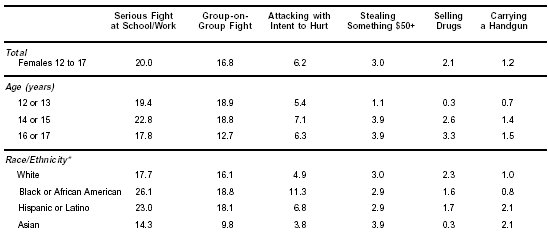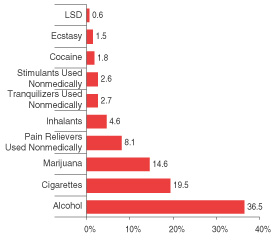
 |
| November 5, 2004 |
|
In Brief |
|
The 2003 National Survey on Drug Use and Health (NSDUH) asked youths aged 12 to 17 to report how often they engaged in the following delinquent behaviors in the past year: (a) serious fighting at school or work, (b) taking part in a fight where a group of friends fought against another group, (c) attacking someone with the intent to seriously hurt them, (d) stealing or trying to steal something worth more than $50, (e) selling illegal drugs, or (f) carrying a handgun.1 Youths were also asked whether they had used cigarettes, alcohol, marijuana, or other illicit drugs in the past year. Illicit drugs include marijuana/hashish, cocaine (including crack), inhalants, hallucinogens, heroin, or prescription-type drugs used nonmedically. Between 1989 and 1998, the number of arrests for index crimes involving juvenile females nationally increased 50 percent2,3 from 284,000 to 427,000 arrests; however, there has been a slight decline since 1998.4 In 2002, juvenile females continued to make up a notable proportion of the arrests for index crimes nationally: approximately 22 percent of all female arrests and 20 percent of all juvenile arrests (Table 40 of 2002 Uniform Crime Reports).5
In 2003, 20.0 percent of females aged 12 to 17 (2.4 million) reported taking part in one or more serious fights at school or work during the past year (Table 1). The percentage of 12– or 13– year-old females and 16– or 17–year-old females who participated in a serious fight at school or work was significantly lower than the percentage of 14– or 15–year-old females (19.4 and 17.8 percent vs. 22.8 percent). A smaller percentage (16.8 percent) of female youths reported participating in a group-on-group fight in the past year. Both 12– or 13–year-old females and 14– or 15–year-old females were more likely than 16– or 17–year-old females to participate in a group-on-group fight in the past year (18.9 and 18.8 percent vs. 12.7 percent) (Table 1). Asian female youths were significantly less likely (9.8 percent) than white (16.1 percent), black (18.8 percent), or Hispanic (18.1 percent) female youths to have participated in a group-on-group fight in the past year. Attacking someone with the intent to hurt them was less frequent among female youths than other fighting behavior. About 6.2 percent of females aged 12 to 17 had attacked someone with the intent to hurt them in the past year; however, the proportion of black female youths who reported participating in this behavior was significantly higher (11.3 percent) than white (4.9 percent), Hispanic (6.8 percent), or Asian (3.8 percent) female youths.
Table 1. Percentages of Female Youths Aged 12 to 17 Who Reported Participating in Delinquent Behaviors One or More Times in the Past Year, by Type of Behavior, Age, and Race/Ethnicity: 2003 |
 |
An estimated 3.0 percent of females aged 12 to 17 reported stealing something worth more than $50, 2.1 percent reported selling drugs on one or more occasions, and only 1.2 percent reported carrying a handgun in the past year (Table 1).
Stealing was more common among older female youths. Only 1.1 percent of females aged 12 or 13 reported stealing or trying to steal something worth $50 or more compared with females aged 14 or 15 and those aged 16 or 17 (both at 3.9 percent). Similarly, the percentage of female youths reporting that they had sold drugs on at least one occasion in the past year increased with age.
Past year substance use was the most prevalent delinquent behavior among females aged 12 to 17. An estimated 36.5 percent of females (4.5 million) reported using alcohol in the past year, 21.9 percent of females (2.7 million) reported using an illicit drug, and 19.5 percent of females (2.5 million) reported past year cigarette use (Figure 1). An estimated 14.6 percent of females aged 12 to 17 reported using marijuana in the past year, and 14.0 percent had used an illicit drug other than marijuana.6 Past year marijuana use and use of any illicit drugs other than marijuana were more prevalent among 16– or 17–year-old females than among 12– or 13–year-old females (Figure 2). Past year nonmedical pain reliever use (8.1 percent) and inhalant use (4.6 percent) also were prevalent among female youths (Figure 1).
Figure 1. Percentages of Female Youths Aged 12 to 17 Who Reported Having Used Selected Substances in the Past Year, by Substance: 2003 |
Figure 2. Percentages of Female Youths Aged 12 to 17 Who Reported Having Used Marijuana or Any Illicit Drug Other Than Marijuana in the Past Year, by Age: 2003 |
 |
 |
The percentage of female youths participating in a serious fight at work or school increased from 16.2 percent in 2002 to 20.0 percent in 2003. Similarly, the proportion of female youths participating in group-on-group fights increased from 13.5 percent in 2002 to 16.8 percent in 2003. In comparison, the percentage of female youths selling drugs in 2003 (2.1 percent) declined from that in 2002 (2.6 percent).
Several past year substance use behaviors among female youths also declined between 2002 and 2003. The percentage of female youths reporting past year cigarette use declined from 21.0 percent in 2002 to 19.5 percent in 2003. In addition, the percentage of female youths reporting past year Ecstasy and LSD use declined between 2002 and 2003; Ecstasy use declined from 2.4 to 1.5 percent, and LSD use declined from 1.1 to 0.6 percent.
* Estimates for American Indian or Alaska Native and Native Hawaiian or Other Pacific Islander respondents are not shown due to small sample sizes.
Source: SAMHSA, 2003 NSDUH.
| The National Survey on Drug Use and Health (NSDUH) is an annual survey sponsored by the Substance Abuse and Mental Health Services Administration (SAMHSA). Prior to 2002, this survey was called the National Household Survey on Drug Abuse (NHSDA). The 2003 data are based on information obtained from 67,784 persons aged 12 or older, of whom 11,028 were female youths aged 12 to 17. The survey collects data by administering questionnaires to a representative sample of the population through face-to-face interviews at their place of residence.
The NSDUH Report is prepared by the Office of Applied Studies (OAS), SAMHSA, and by RTI International in Research Triangle Park, North Carolina. (RTI International is a trade name of Research Triangle Institute.) Information and data for this issue are based on the following publication and statistics: Information and data for this issue are based on the following publication and statistics: Office of Applied Studies. (2004). Results from the 2003 National Survey on Drug Use and Health: National findings (DHHS Publication No. SMA 04–3964, NSDUH Series H–25). Rockville, MD: Substance Abuse and Mental Health Services Administration. Also available online: http://www.oas.samhsa.gov. Because of improvements and modifications to the 2002 NSDUH, estimates from the 2002 and 2003 surveys should not be compared with estimates from the 2001 or earlier versions of the survey to examine changes over time. |
The NSDUH Report (formerly The NHSDA Report) is published periodically by the Office of Applied Studies, Substance Abuse & Mental Health Services Administration (SAMHSA). All material appearing in this report is in the public domain and may be reproduced or copied without permission from SAMHSA. Additional copies of this report or other reports from the Office of Applied Studies are available on-line: http://www.oas.samhsa.gov. Citation of the source is appreciated. For questions about this report please e-mail: shortreports@samhsa.hhs.gov.
|
 This page was last updated on May 16, 2008. |
|
SAMHSA, an agency in the Department of Health and Human Services, is the Federal Government's lead agency for improving the quality and availability of substance abuse prevention, addiction treatment, and mental health services in the United States. 
* PDF formatted files require that Adobe Acrobat Reader® program is installed on your computer. Click here to download this FREE software now from Adobe. |